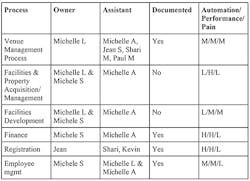Using Project Management to Improve Process Management —
It is common knowledge in the Project Management (PM) field that PM helps with PM; projects go much more smoothly and efficiently if you have consistent, process for doing your projects. It’s the same in every other area of your company where you do the same repetitive work: you need robust, transparent, and consistent processes. All companies have processes and projects; processes are for managing the work you do day in and day out, projects are for your one-time efforts.
You need to have a consistent process for doing your projects — and creating and updating the processes used to run the business, are a project. A project, as defined by the Project Management Institute (PMI), "is temporary in that it has a defined beginning and end in time, and therefore defined scope and resources And a project is unique in that it is not a routine operation, but a specific set of operations designed to accomplish a singular goal" (PMI 2017). Projects are what you do when things are changing in order to meet the requirements of the change. Designing or updating the processes that run the business so they are testable, reliable, robust, and transparent, is, in fact, one of the most important projects you can do to have a successful company.
The first step in carrying out the project of establishing PM in your organization is to identify each of your organization’s processes — your everyday operations. At Cheetah Learning, we identified 20 core processes that are the bread-and-butter of our business.
The 20 core processes are:
1. Course Development
2. Student and Instructor Kits
3. Course Upgrades
4. Train the Trainer
5. Emergency Response
6. Venue Management
7. Registration
8. Websystem and Upgrades
9. IT Infrastructure Support
10. Customer Relations
11. Corporate Sales
12. Marketing
13. Marketing Events
14. Marketing Literature
15. Finance
16. Employee Management
17. Facilities Acquisition
18. Facilities Development
19. Asset Management
20. Risk Management
After identifying our processes, we name the owner of the process, other employees assisting with the process, process documentation, and the levels (high, medium, and low) of automation, performance, and pain (difficulty) of the process.
The table below shows how we do this for 6 of our key processes:
In our decades of doing and teaching Project Management, we at Cheetah Learning have developed 3 key principles for doing the project of improving our processes:
1. start only one process update at a time,
2. finish it fast, and
3. scale down our process improvement activities so we achieve something of significant improvement in less than 2 weeks.
To learn more about Cheetah’s online courses in PM and our Cheetah Exam Prep for the PMP Exam classroom course, visit www.cheetahlearning.com.
About the Author

